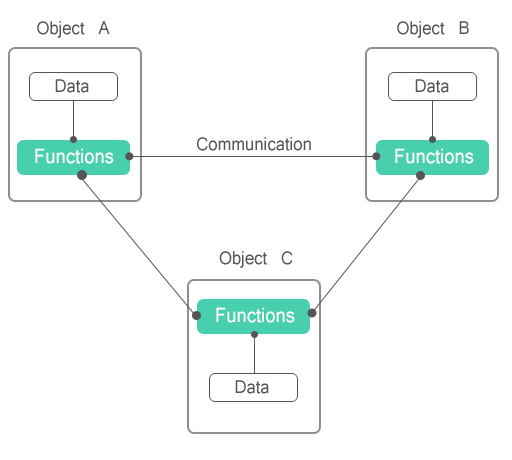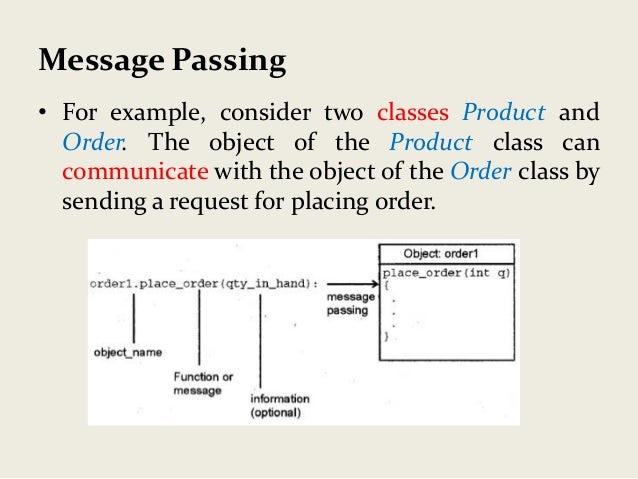Object Oriented Paradigm
The major motivating factor in the invention of object-oriented approach is to remove
some of the flaws encountered in the procedural approach. OOP treats data as a critical
element in the program development and does not allow it to flow freely around the
system. It ties data more closely to the function that operate on it, and protects it from
accidental modification from outside function. OOP allows decomposition of a problem
into a number of entities called objects and then builds data and function around these
objects. The organization of data and function in object-oriented programs is shown in
fig.1.3. The data of an object can be accessed only by the function associated with that
object. However, function of one object can access the function of other objects.
Organization of data and function
 |
| Add caption |
Some of the features of object oriented programming are:
• Emphasis is on data rather than procedure.
• Programs are divided into what are known as objects.
• Data structures are designed such that they
characterize the objects
• Functions that operate on the data of an object are ties together in the data
structure.
• Data is hidden and cannot be accessed by external function.
• Objects may communicate with each other through function.
• New data and functions can be easily added whenever necessary.
• Follows bottom up approach in program design.
Object-oriented programming is the most recent
concept among programming
paradigms and still means different things to different people.
1.5 Basic Concepts of Object Oriented Programming
It is necessary to understand some of the concepts used extensively in object-oriented
programming. These include:
• Objects
•
Classes
•
Data abstraction and encapsulation
• Inheritance
• Polymorphism
• Dynamic binding
• Message passing
We shall discuss these concepts in some detail in this section.
1 OBJECT
Objects are the basic run time entities in an object-oriented system. They may represent a
person, a place, a bank account, a table of data or any item that the program has to
handle. They may also represent user-defined data such as vectors, time and lists.
Programming problem is analyzed in term of objects and the nature of communication
between them. Program objects should be chosen such that they match closely with the
real-world objects. Objects take up space in the memory and have an associated address
like a record in Pascal, or a structure in c.
When a program is executed, the objects interact by sending messages to one another.
Foe example, if “customer” and “account” are to object in a program, then the customer
object may send a message to the count object requesting for the bank balance. Each
object contain data, and code to manipulate data. Objects can interact without having to
know details of each other’s data or code. It is a sufficient to know the type of message
accepted, and the type of response returned by the objects. Although different author

2 Classes
We just mentioned that objects contain data, and code to manipulate that data. The entire
set of data and code of an object can be made a user-defined data type with the help of
class. In fact, objects are variables of the type class. Once a class has been defined, we
can create any number of objects belonging to that class. Each object is associated with
the data of type class with which they are created. A class is thus a collection of objects
similar types. For examples, Mango, Apple and orange members of class fruit. Classes
are user-defined that types and behave like the built-in types of a programming language.
The syntax used to create an object is not different then the syntax used to create an
integer object in C. If fruit has been defines as a class, then the statement
Fruit Mango;
Will create an object mango belonging to the class fruit.
.3 Data Abstraction and Encapsulation
The wrapping up of data and function into a single unit (called class) is known as
encapsulation. Data and encapsulation is the most striking feature of a class. The data is
not accessible to the outside world, and only those functions which are wrapped in the
class can access it. These functions provide the interface between the object’s data and
the program. This insulation of the data from direct access by the program is called data
hiding or information hiding.
Abstraction refers to the act of representing essential features without including the
background details or explanation. Classes use the concept of abstraction and are defined
as a list of abstract attributes such as size, wait, and cost, and function operate on these
attributes. They encapsulate all the essential properties of the object that are to be created.
The attributes are some time called data members because they hold information. The
functions that operate on these data are sometimes called methods or member function.
Inheritance
is the process by which objects of one class acquired the properties of objects
of another classes. It supports the concept of hierarchical classification. For example,
the bird, ‘robin’ is a part of class ‘flying bird’ which is again a part of the class ‘bird’.
The principal behind this sort of division is that each derived class shares common
characteristics with the class from which it is derived as illustrated in fig 1.6.
In OOP, the concept of inheritance provides the idea of reusability. This means that we
can add additional features to an existing class without modifying it. This is possible by
deriving a new class from the existing one. The new class will have the combined feature
of both the classes. The real appeal and power of the inheritance mechanism is that it
Fig. 1.6 Property inheritances

Allows the programmer to reuse a class i.e almost, but not exactly, what he wants, and to
tailor the class in such a way that it does not introduced any undesirable side-effects into
the rest of classes.
Polymorphism
is another important OOP concept. Polymorphism, a Greek term, means
the ability to take more than on form. An operation may exhibit different behavior is
different instances. The behavior depends upon the types of data used in the operation.
For example, consider the operation of addition. For two numbers, the operation will
generate a sum. If the operands are strings, then the operation would produce a third
string by concatenation. The process of making an operator to exhibit different behaviors
in different instances is known as operator overloading.
Fig. 1.7 illustrates that a single function name can be used to handle different number
and different types of argument. This is something similar to a particular word having
several different meanings depending upon the context. Using a single function name to
perform different type of task is known as function overloading.

.6 Dynamic Binding
Binding refers to the linking of a procedure call to the code to be executed in response to
the call. Dynamic binding means that the code associated with a given procedure call is
not known until the time of the call at run time. It is associated with polymorphism and
inheritance. A function call associated with a polymorphic reference depends on the
dynamic type of that reference.
Consider the procedure “draw” in fig. 1.7. by inheritance, every object will have this
procedure. Its algorithm is, however, unique to each object and so the draw procedure
will be redefined in each class that defines the object. At run-time, the code matching the
object under current reference will be called.
.7 Message Passing
An object-oriented program consists of a set of objects that communicate with each other.
The process of programming in an object-oriented language, involves the following basic
steps:
1. Creating classes that define object and their behavior,
2. Creating objects from class definitions, and
3. Establishing communication among objects.
Objects communicate with one another by sending and receiving information much the
same way as people pass messages to one another. The concept of message passing
makes it easier to talk about building systems that directly model or simulate their realworld
counterparts.
A Message for an object is a request for execution of a procedure, and therefore will
invoke a function (procedure) in the receiving object that generates the desired results.
Message passing involves specifying the name of object, the name of the function
(message) and the information to be sent. Example:
Employee. Salary (name);

Object has a life cycle. They can be created and destroyed. Communication with an
object is feasible as long as it is alive.
1.6 Benefits of OOP
OOP offers several benefits to both the program designer and the user. ObjectOrientation
contributes to the solution of many problems associated with the
development and quality of software products. The new technology promises greater
programmer productivity, better quality of software and lesser maintenance cost. The
principal advantages are:
• Through inheritance, we can eliminate redundant code extend the use of existing
• Classes.
• We can build programs from the standard working modules that communicate
with one another, rather than having to start writing the code from scratch. This
leads to saving of development time and higher productivity.
• The principle of data hiding helps the programmer to build secure program that
can not be invaded by code in other parts of a programs.
• It is possible to have multiple instances of an object to co-exist without any
interference.
• It is possible to map object in the problem domain to those in the program.
• It is easy to partition the work in a project based on objects.
• The data-centered design approach enables us to capture more detail of a model
can implemental form.
• Object-oriented system can be easily upgraded from small to large system.
• Message passing techniques for communication between objects makes to
interface descriptions with external systems much simpler.
• Software complexity can be easily managed.
While it is possible to incorporate all these features in an object-oriented system, their
importance depends on the type of the project and the preference of the programmer.
There are a number of issues that need to be tackled to reap some of the benefits stated
above. For instance, object libraries must be available for reuse. The technology is still
developing and current product may be superseded quickly. Strict controls and protocols
need to be developed if reuse is not to be compromised.
PART 2







